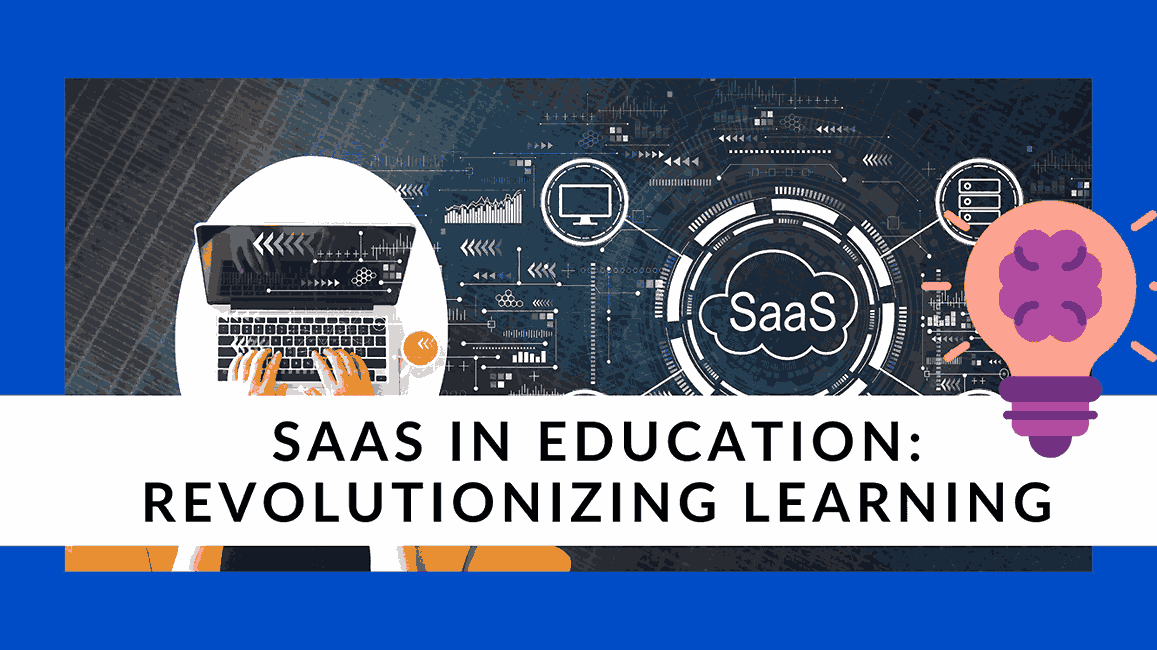SaaS in Education: Revolutionizing Learning


In a world where technology is reshaping every aspect of our lives, it is no surprise that Software-as-a-Service (SaaS) has emerged as a game-changer in the education sector. With its ability to deliver powerful applications and services over the internet, SaaS is revolutionizing learning experiences like never before.
But what makes SaaS so significant in education? It’s simple – accessibility and affordability. By leveraging cloud-based solutions, educational institutions can now provide students and educators with seamless access to cutting-edge tools and resources anytime, anywhere.
Cloud-Based Learning Management Systems (LMS)
Cloud-based Learning Management Systems (LMS) have emerged as powerful tools that revolutionize the way educational institutions deliver and manage their courses. These systems offer many benefits, providing accessible anytime, anywhere learning opportunities while ensuring scalability and flexibility for educational institutions.
One of the key advantages of cloud-based LMS is its ability to break down barriers by offering accessible learning experiences. Students can access course materials, submit assignments, and engage in discussions from any location with an internet connection. This flexibility allows learners to study independently and provides opportunities for remote or blended learning models.
Scalability is another crucial benefit offered by cloud-based LMS. Educational institutions can easily scale up or down based on student enrollment without worrying about infrastructure limitations or costly hardware upgrades. Additionally, these systems provide educators with flexible tools for creating and managing courses effectively.
The Clear Insights platform discusses the transformation of education with emerging educational SaaS industries, shedding more light on this transformative technology.
The features and functionalities embedded within cloud-based LMS are designed to enhance teaching methodologies and improve student engagement. Course management features enable educators to create interactive lessons, track attendance records efficiently, grade assignments digitally, and provide timely feedback to students.
Collaboration tools foster peer-to-peer interaction through discussion boards or group projects, while student engagement features encourage active participation through gamification elements or multimedia content integration.
Personalized Learning and Adaptive Platforms
There is no one-size-fits-all solution in education. Each student has unique learning needs, strengths, and areas for improvement. To address these individual differences effectively, personalized learning and adaptive platforms have emerged as powerful tools that revolutionize traditional classroom approaches.
Adaptive learning technologies lie at the heart of personalized instruction. These innovative systems utilize sophisticated algorithms to create individualized learning paths based on student’s progress and abilities.
By continuously assessing their performance and understanding their areas of strength or weakness, adaptive platforms can provide targeted interventions that address specific knowledge gaps or challenges. This ensures that students receive precisely what they need for optimal growth and mastery.
This article on LinkedIn discusses how the adoption of Software-as-a-Service is transforming learning experiences, providing a deeper understanding of the impact of SaaS in education.
Smart tutoring systems further enhance personalized instruction by delivering tailored guidance to each learner. These intelligent platforms analyze data from various sources – assessments, quizzes, or interactive modules – to better understand students’ specific requirements. With this information, Smart tutoring systems offer customized feedback, explanations, and resources that cater directly to each student’s unique needs.
Data-driven insights derived from these adaptive platforms are invaluable for educators and learners. By analyzing comprehensive learning analytics generated by these systems in real time, educators gain deep insights into student performance trends across different topics or skill sets.
This enables them to identify areas for improvement promptly while designing adaptive curriculum plans that target those specific needs effectively.
For learners themselves, access to data-driven insights empowers them with a clearer understanding of their strengths as well as growth opportunities. By encouraging self-reflection, learners will develop a sense of ownership over their educational journey, ultimately leading to more engaged and motivated learners.
Virtual Classrooms and Remote Learning
The education landscape has undergone a seismic shift with the rise of virtual classrooms and remote learning. As technology continues to advance, these innovative approaches are reshaping traditional educational models, offering new opportunities for collaboration, engagement, and access to knowledge.
The Times of India provides valuable insights into what SaaS is and why it’s beneficial for schools, further exploring the benefits of SaaS in education.
Online collaboration tools and virtual classrooms have become essential to remote learning experiences. With interactive video conferencing capabilities and real-time collaboration features, students can engage in discussions, ask questions, and work together on projects regardless of physical location. These digital platforms simulate the dynamics of a traditional classroom environment by fostering active participation and facilitating meaningful interactions among peers.
Blended learning and flipped classroom models further enhance the benefits of virtual classrooms. By combining online instruction with in-person sessions or practical activities, educators can create a dynamic learning experience that caters to diverse student needs.
Students can access course materials remotely at their own pace while reserving face-to-face time for collaborative projects or deeper discussions with teachers. This hybrid approach allows for flexibility while promoting active engagement in both online and offline settings.
Education Content and Resource Management
Education content and resource management have evolved to streamline processes, enhance collaboration, and ensure easy access to educational materials. Technology has paved the way for innovative solutions that empower educators with tools for creating, sharing, and managing content effectively.
Digital content creation and distribution have transformed traditional teaching materials into interactive and engaging resources. Authoring tools enable educators to create multimedia-rich content such as videos, simulations, or interactive quizzes that cater to different learning styles. These tools make lessons more captivating and allow for customization based on specific curriculum requirements.
Sharing and distributing educational resources has become seamless with digital platforms. Educators can easily upload their materials onto centralized repositories accessible by students at any time from anywhere. This eliminates the need for physical copies while ensuring equitable access to learning resources for all learners.
This CXO Today article explores how SaaS is changing the game in K-12 education, emphasizing the revolutionizing role of SaaS in education.
Resource and curriculum management systems provide a centralized hub where educators can organize educational materials efficiently. These platforms act as repositories where teachers can store, search for, update, or share various types of content – from lesson plans to assessments – saving valuable time searching through physical files or disparate online sources.
Customizable curriculum frameworks further enhance resource management by allowing educators to adapt instructional plans according to student needs or changing standards. With these frameworks, teachers can align their instruction with desired outcomes while maintaining flexibility in tailoring lessons based on individual classroom dynamics.
Assessment and Feedback Systems
Assessment and feedback are crucial components of the learning process, providing valuable insights into student progress and offering guidance for improvement.
Online assessment and grading tools have simplified the evaluation process for educators. These platforms employ automated mechanisms to grade assignments efficiently while providing instant student feedback. Through features such as rubrics or scoring algorithms, teachers can ensure consistency in evaluating student work while saving time on manual grading tasks.
Quizzes and assignments conducted through online systems allow educators to assess student knowledge in a dynamic format. With interactive question types, multimedia integration, and immediate results generation, these assessments engage learners actively while providing real-time feedback on their understanding of the material.
Learning analytics play a significant role in monitoring student progress and identifying areas for improvement. By leveraging data-driven insights from various sources, such as quizzes or participation records, educators gain a comprehensive overview of individual strengths, weaknesses, and overall class performance. This analytics help identify specific areas where students may struggle or excel, enabling targeted interventions to address gaps or provide additional challenges accordingly.
Timely feedback is invaluable in personalized learning journeys. With online assessment systems’ ability to generate instant results, students receive prompt feedback on their performance – allowing them to reflect on their strengths and identify growth opportunities. This enables them to take ownership of their own learning experience while making informed decisions about their academic journey.
Conclusion
The adoption of Software-as-a-Service (SaaS) solutions in education is revolutionizing learning experiences. Through personalized and adaptive platforms, educators can tailor instruction to meet individual student needs, empowering them to reach their full potential. Additionally, virtual classrooms and remote learning tools have opened up new possibilities for collaboration and access to educational resources.
Looking ahead, the outlook for the SaaS industry remains highly promising. As businesses prioritize flexibility and cost-effectiveness in software solutions, cloud-based applications will be in high demand. Furthermore, with technological advancements and a growing emphasis on remote work capabilities, the need for innovative SaaS platforms is set to thrive.
By harnessing these powerful technologies, the education sector can unlock new opportunities and transform how knowledge is imparted. As we embrace this exciting journey, we anticipate a future where education knows no boundaries – where every learner can access high-quality resources, personalized instruction, and enhanced learning experiences.





